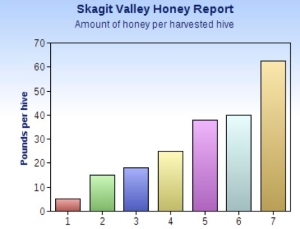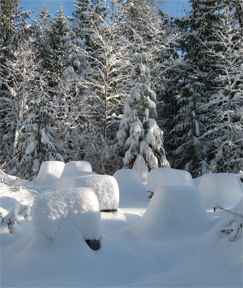“How much honey did you get this year?” is a questioned often asked by beekeepers of each other. “How much honey do you get per hive?” is a similar question asked by customers and folks contemplating going into beekeeping.
The first question I hate. It’s a bit too much like a competition. How far can you throw? How much can you lift? It all depends on a lot of factors, so comparisons between beekeepers are at best silly.
The second question: “How much honey can you (or did you) get per hive?” is a good one.
The answer will still depend on a lot of variables.
FACTORS THAT CAN AFFECT HONEY HARVEST
- Weather (Rain? Drought?)
- Temperature (Too hot, too cold?)
- Hive placement (some locations look good, but turn out bad)
- Hive moments (pollination can supply honey, but some plants produce little nectar)
- Diseases
- Pests
- Pesticide exposure
- Competition (a nice bee yard will take less if a lot of pollinating hives are dropped near-by)
- How much honey one leaves for the bees (a very important question)
But it is nice to know the average in your area, and what other beekeepers are going though.
HOT YEAR IN EASTERN WASHINGTON
Eastern Washington State burned this year. Not just in the sense of burning hot temperature. It actually burned – for weeks. Rain has been scare there in the past few years (as with many places in the US and world-wide). This year was horrid. Wildflowers did not produce nectar – they need water for that. One commercial beekeeper I know found that over half of his hives did not have honey in them.
Think about your business. What affect would if have on your income if you could only produce half of what you create, be it widgets or proposals or bees or honey. To say the situation is troublesome is an understatement.
WEST WASHINGTON RAINS
Western Washington did OK this year. When it’s “dry” here, that means we might get a few weeks of clear weather in between rainstorms. Which means that the drought’s effect in the northwest corner of the state was to produce a remarkably good honey harvest this year.
HOW MUCH HONEY PER HIVE WASHINGTON STATE
I have two friends, Ron Babcock and Pat Ray, who have been beekeepers in Western Washington State for over 20 years.
I asked each of them how much honey they figured they would get from a west Washington hive in an “average” year. Each one promptly said a study had shown the state average is 30 pounds of honey per hive.
Bear in mind that average is for the state of Washington. The majority of Washington’s honey is produced east of the Cascade Range, a drier area than our wet area lodged between the Salish Sea and the towering mountains.
Ron mused a bit on the 30-pounds-per-hive average, adding that could be used as a guide “ if it’s all letter perfect – but you can’t count on that. No diseases, no vandal knocking over your hives. It’s farming and dealing with Mother Nature…rain, contents of the soil, the temperature that some plants produce at and some don’t produce.”
A SKAGIT VALLEY HONEY HARVEST/ BEEKEEPER SURVEY
Robert Niles, the editor of the Skagit Valley Beekeepers Association newsletter ran a voluntary survey of members this year about how much honey they got (my hated question) and about how much per hive (the question I like.)
Skagit Valley is in the county just south of Whatcom County, where I live and keep bees. Skagit Valley is about 50 miles south of the Canadian border and stretches from Puget Sound to the high Cascade mountain range. It has agricultural areas, river valleys, cities, towns, and high mountains. The Association has beekeepers from a range of these areas.
Robert asked members to volunteer how much honey they harvested from their hives and how much honey they averaged per hive. All reporting would be anonymous.
A number of beekeepers supplied the answer to “How Much Honey Did You Get”. You know my view on this without knowing hive numbers, but here’s what Robert found: “the median [was] 35 pounds and the most common harvest reports being between 30-35 pounds of honey.”
Seven members supplied the more important question: “How Much Honey Per Hive”.
The lowest was 5 pounds-per-hive, the highest 62 pounds-per-hive.
“The average was just over 29 pounds per hive (with the outliers removed, the average still was close at 27 pounds per hive).” Robert reported in the newsletter. “The median being 25 pounds and with the sample being so small, the mode isn’t figured in.”
BROOKFIELD FARM HONEY HARVEST:
I took an average of 18 pounds from each of my hives. This is an average: some hives delivered nearly 80 pounds of honey; some delivered none. Often these were in the same bee yard – every hive is unique, some have better foragers, some decide to replace their queen or swarm in the middle of a honey flow (a good moment for them – lots of food; a lousy moment for the beekeeper – little honey for harvest).
I could have taken more, according to all “bee wisdom”, but I leave a lot of honey on my hives: 70 pounds for each full hive; 50 for smaller hives. We have some long winters here.
The smaller hives are often nucs that were started earlier in the year. By fall they have enough bees to over winter, but have often not put up enough stores. We do not see nectar in my area from October to March (that is if it does not rain throughout March).
The extra honey for these hives is pulled from the honey I’ve harvested for sale. I would rather harvest less, but give the bees real honey and not feed syrup (I do good syrup, but it’s not honey). Diseases can be passed between hives this way, but I am willing to take that risk to give a smaller hive honey for the winter instead of feed.
In the spring, I sometimes have to rearrange frames of honey because the bees have clustered in a manner that they are missing their stores, but at least it’s still honey.
BEES AND BEEKEEPERS
The bees are still buzzing around, but there are few flowers in bloom here. The rains have arrived (always after October 13 for some reason). The hives are pretty much shut down for the winter. Me? Well, I’ve got boxes and frames to make and stain. Frames to wire. Salves to make. As with most beekeepers in this area, the work never really ends, it just changes to inside work as we stare out at the hives and hope that all is well with the bees until we see them in the spring.
That’s the news from Brookfield Farm Bees And Honey, in Maple Falls, Washington. How did














Karen, a very nice well written article. Thank you, Brad
Other beekeepers often tell me they’ve managed to get huge figures like 3-4 supers (90-120 pounds) per hive. Whereas Emma and I get about 1 super (30 pounds) per hive if we’re lucky. Like you say, I think location makes a big difference – there’s a lot of hives around in west London, so plenty of competition for forage.
I’m always a bit suspicious when the numbers go way high compared to other local hives. It’s either a brilliant location or something else could be happening: robbing? alternative sources (remember the “colored honey” after bees found and M&M’s processing plant with open vats?)? a bit of off-season feeding? or perhaps just taking to much?… When I began beekeeping I would get 50lb/hive. Of course I had a “small” problem that the bees often did not have enough food by spring…. Now I take less, leave more, and at worst, I’ve got honey for early season splits or chubby bees in the spring
How many pounds in a qurt
Should be just under 3 pounds – mine weigh out at 46 oz – 2 oz under 3 pounds. But it depends on how the beekeeper is pouring the honey…
Kewl
It did not answer my question.
What were you trying to figure out? Maybe we can find someone who can help.